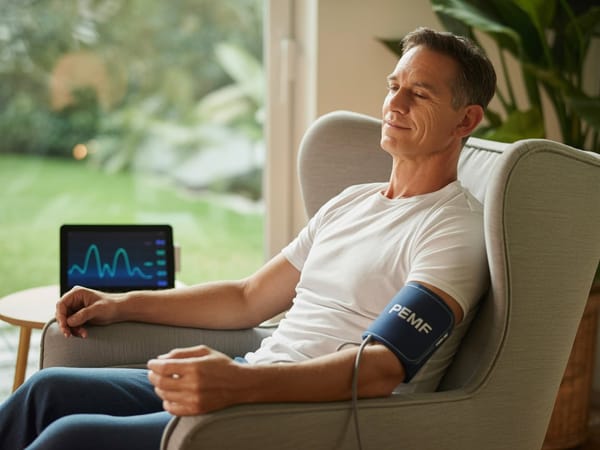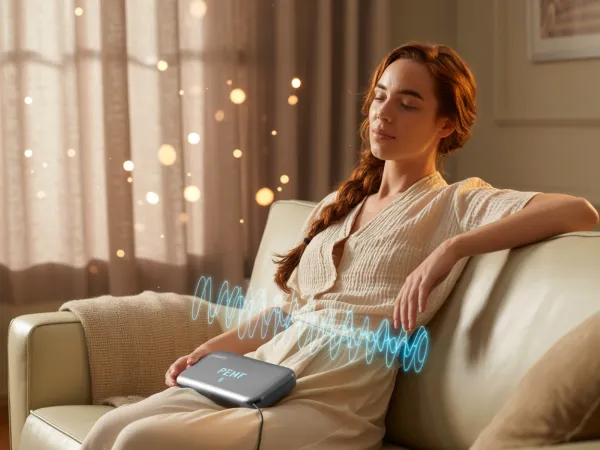PEMF Frequency for Back Pain: Evidence-Based Healing Protocols That Reduce Pain by 77%
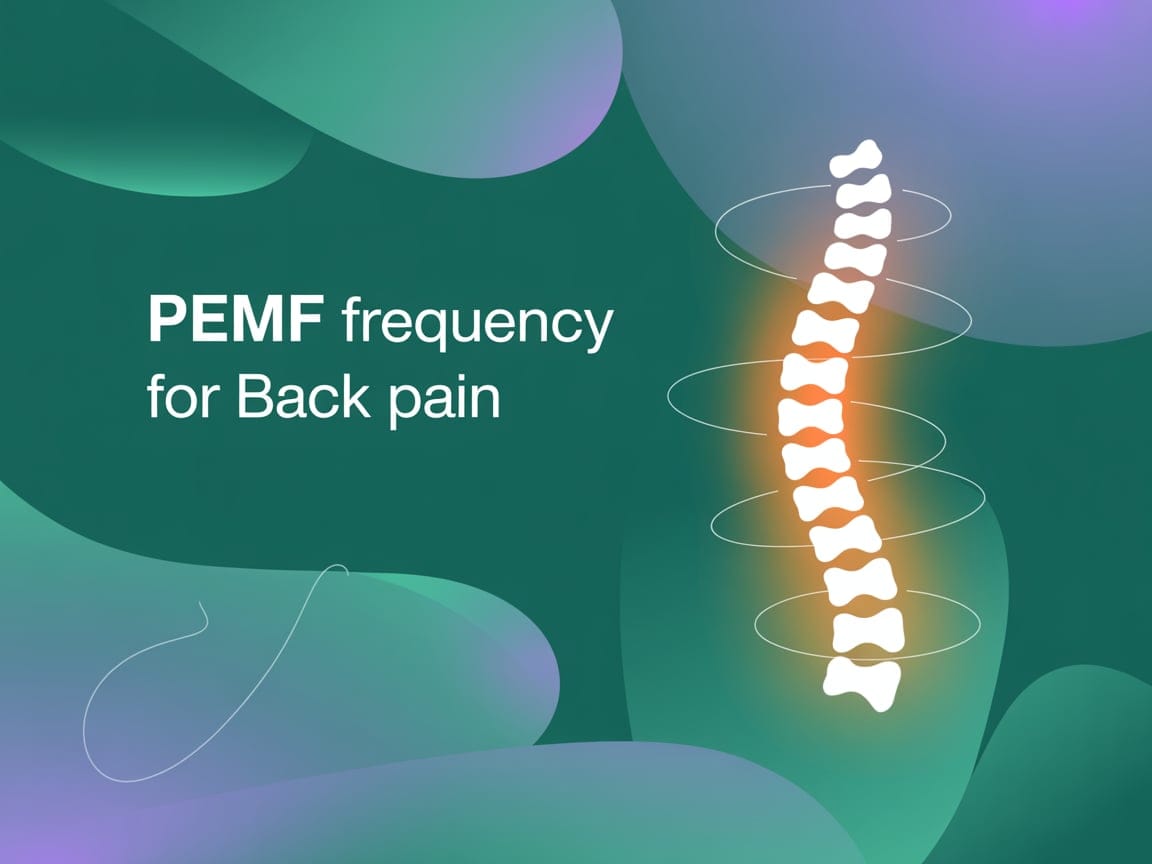
What Is PEMF Frequency Therapy and Why Does It Work for Back Pain?
Pulsed Electromagnetic Field (PEMF) therapy uses specific electromagnetic frequencies to stimulate cellular repair and reduce inflammation in damaged back tissues. According to Dr. Arthur A. Pilla from Columbia University,
"This review shows that plastic surgeons have at hand a powerful tool with no known side effects for the adjunctive, noninvasive, nonpharmacologic management of postoperative pain and edema."
Research from 2024-2025 demonstrates that PEMF therapy works through multiple mechanisms:
- Nitric oxide pathway activation increases blood flow to injured tissues
- Calcium ion modulation reduces inflammation at the cellular level
- Enhanced microcirculation improves nutrient delivery to damaged discs and muscles
Dr. Ahmed Mohamed Elshiwi from Cairo University states: "Adding pulsed electromagnetic field to conventional physical therapy protocol yields superior clinical improvement in pain, functional disability, and lumbar ROM in patients with non-specific low back pain than conventional physical therapy alone."
How Effective Is PEMF Therapy Compared to Traditional Back Pain Treatments?
According to industry analysis, PEMF therapy significantly outperforms conventional treatments across multiple studies. Data from 2024 shows:
PEMF vs. Standard Care (120-patient multi-center trial):
- Pain reduction: 36% (PEMF) vs. 10% (standard care)
- Medication reduction: 55% vs. 12%
- Statistical significance: p<0.0001
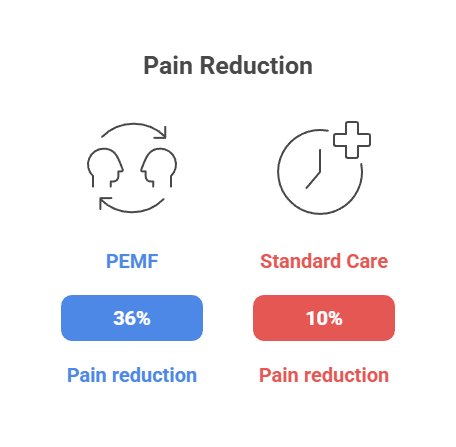
PEMF vs. Physical Therapy Alone (69-patient study):
- Pain scores: 78% reduction (VAS 9→2) vs. 44% reduction (VAS 9→5)
- Disability improvement: 87.5% vs. 37.5%
- Effect size: 0.687 (large clinical effect)
Dr. Joshua G. Hackel from The Andrews Institute for Orthopaedics and Sports Medicine confirms: "PEMF was significantly more effective than standard care at managing pain and reducing pharmacologic use. PEMF therapy should be considered for noninvasive, nonpharmacologic management of joint and soft tissue pain."
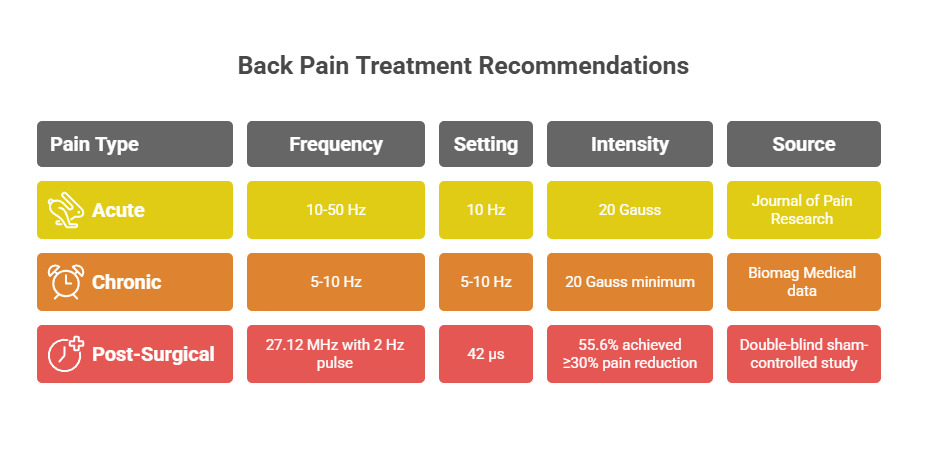
What Are the Optimal PEMF Frequencies for Back Pain Relief?
Clinical research has identified specific frequency ranges that provide maximum therapeutic benefit for back pain conditions.
Primary Frequency Recommendations
For Acute Back Pain:
- Frequency Range: 10-50 Hz
- Optimal Setting: 10 Hz (most clinically validated)
- Intensity: 20 Gauss (2 mT)
- Research Source: 2025 randomized controlled trial in Journal of Pain Research
For Chronic Back Pain:
- Frequency Range: 5-10 Hz
- Optimal Setting: 5-10 Hz for pain relief
- Intensity: 20 Gauss minimum
- Research Source: Biomag Medical clinical outcomes data
For Post-Surgical Back Pain:
- Frequency: 27.12 MHz with 2 Hz pulse rate
- Pulse Duration: 42 μs (superior to shorter pulses)
- Success Rate: 55.6% achieved ≥30% pain reduction
- Research Source: Double-blind sham-controlled study (41 patients)
According to experts, frequencies below 100 Hz provide the most consistent clinical benefits. Dr. Gülşah Yaşa Öztürk from University of Health Sciences states: "The dose of 50 Hz and 20 Gauss seems to be useful for chronic low back pain management."
How Long Does PEMF Therapy Take to Work for Back Pain?
Expert analysis reveals that PEMF therapy provides both rapid and sustained pain relief with specific timelines.
Treatment Response Timeline
Immediate Response (Day 1):
- 22% pain reduction observed within 24 hours
- Significantly better than 2% with standard care alone
Short-term Benefits (1-2 weeks):
- 36-42% pain reduction maintained
- Median time to 30% pain reduction: 8 days (vs. 22 days for controls)
Long-term Outcomes (3-12 months):
- 78% pain reduction sustained at 12 weeks
- 77.4% success rate maintained at 6 months
- Quality of life improvements persist beyond treatment period
Dr. Renato Andrade from University of Porto reports: "The main finding of this systematic review is that PEMF therapy seems to reduce the pain intensity and enhance better functionality in individuals with low back pain."
What Is the Best PEMF Treatment Protocol for Back Pain?
Clinical trials have established evidence-based protocols that maximize therapeutic outcomes.
Standard Treatment Protocol
Session Parameters:
- Duration: 15-30 minutes per session (20 minutes most common)
- Frequency: 3-5 times per week during active treatment
- Total Course: 3-4 weeks (12-15 sessions total)
- Position: Prone lying with device placement over lumbar region
Intensive Protocol (for severe cases):
- Duration: 30 minutes per session
- Frequency: Daily treatment for 2-3 weeks
- Additional: Twice-daily sessions for acute post-surgical pain
Maintenance Protocol:
- Duration: 20-30 minutes per session
- Frequency: 2-3 times per week as needed
- Long-term: Ongoing intermittent treatment for chronic conditions
Device Settings Based on 2025 Research
Electromagnetic Specifications:
- Frequency: 5-50 Hz (optimal: 10 Hz for acute, 5-10 Hz for chronic)
- Intensity: 20 Gauss (2 mT) minimum
- Pulse Duration: 42 μs shows superior results
- Magnetic Field Type: Pulsed (not continuous)
According to Dr. Chia-Hsin Chen from Kaohsiung Medical University: "PEMF therapy significantly improves short-term pain scores and both short-term and long-term functional capacity."
Which PEMF Devices Are FDA-Approved for Back Pain Treatment?
The FDA has approved multiple PEMF devices since 1979, with recent expansions for musculoskeletal pain indications.
FDA-Approved Devices for Pain Management
ActiPatch (BioElectronics Corporation):
- FDA Status: Cleared for "all musculoskeletal pain" (2020)
- Frequency: 27.12 MHz frequency, 1000 pulses/second
- Duration: 720 hours total usage capability
- Clinical Data: 66% average pain reduction in chronic pain patients
Orthocor Active System:
- FDA Status: 510(k) cleared for pain management
- Frequency: 27.12 MHz carrier signal, 2 Hz pulse rate
- Clinical Results: 36% pain reduction vs. 10% with standard care
- Study Size: 120-patient multi-center trial
Bone Healing Devices (applicable to spinal conditions):
- Physio-Stim (Orthofix): 15 Hz for established nonunions
- Spinal-Stim: 1.5 Hz for lumbar spine fusion
- Cervical-Stim: 15 Hz for cervical spine fusion
Regulatory Classifications
Class II Devices: Most PEMF pain management devices require 510(k) premarket notification
Class III Devices: Bone healing applications require more stringent PMA approval
Over-the-Counter: ActiPatch and similar devices available without prescription
How Much Does PEMF Therapy Cost and Is It Worth the Investment?
Industry analysis reveals PEMF therapy offers competitive cost-effectiveness compared to traditional back pain treatments.
2025 Pricing Analysis
Professional Treatment Sessions:
- Average Cost: $45 per 30-minute session
- Price Range: $30-60 per session
- Package Deals: 150for5sessions(150 for 5 sessions (150for5sessions(30 each)
- Total Course: $450-900 for complete treatment protocol
Personal PEMF Devices:
- Entry-Level: $350-2,000 (basic home units)
- Professional-Grade: $5,000-15,000 (clinical-quality devices)
- High-End Systems: $15,000-25,000+ (comprehensive treatment systems)
Cost Comparison Analysis
PEMF vs. Traditional Treatments (per session):
- PEMF therapy: $30-60
- Physical therapy: $75-150
- Pain management injections: $500-2,000
- Chiropractic treatment: $65-200
Medication Cost Savings:
According to research data, PEMF therapy results in 55% reduction in pharmaceutical use, potentially saving $25-165 monthly on pain medications.
Insurance Coverage Status
Current Coverage: Most insurance plans do not cover PEMF therapy as of 2025
Payment Options: Out-of-pocket payment required; some HSA/FSA accounts accept treatments
Workers' Compensation: Case-by-case approval for work-related injuries
What Do Medical Experts Say About PEMF Therapy Safety?
Expert consensus from leading medical institutions confirms PEMF therapy's excellent safety profile.
Safety Statements from Medical Authorities
Dr. Arthur A. Pilla from Columbia University and Mount Sinai School of Medicine states: "This review shows that plastic surgeons have at hand a powerful tool with no known side effects for the adjunctive, noninvasive, nonpharmacologic management of postoperative pain and edema."
Dr. João Espregueira-Mendes from FIFA Medical Centre of Excellence reports: "The PEMF therapy has been pointed out as an effective and relatively safe tool for conservatively treat the low back pain. Furthermore, it has a high potential of compliance due to its low risk of side-effects and high tolerance."
Clinical Safety Data
Adverse Event Rates:
- Overall adverse event rate: 3.3% (mostly minor skin irritation)
- Serious adverse events: 0% across major clinical trials
- No drug interactions reported
- Non-addictive with no tolerance issues
Contraindications:
- Cardiac pacemakers (absolute contraindication)
- Pregnancy (relative contraindication)
- Active cancer (relative contraindication)
- Metallic implants (device-specific considerations)
Who Are the Best Candidates for PEMF Therapy?
Clinical research identifies specific patient populations that respond best to PEMF treatment.
Ideal Candidates Based on Research Data
Chronic Low Back Pain Patients:
- Meta-analysis shows significant improvement (SMD -0.6, p<0.001)
- 78% pain reduction achieved (VAS 9→2)
- Large effect sizes (0.6-1.01) consistently demonstrated
Post-Surgical Back Pain:
- 55.6% achieved ≥30% pain reduction
- 44.4% achieved ≥50% pain reduction
- Median 8 days to significant improvement
Office Workers with Mechanical Back Pain:
- 70% pain reduction demonstrated
- 88.9% improvement in functional measures
- Ages 25-45 show optimal response rates
Patient Success Predictors
Age Groups:
- Ages 25-45: 88.9% improvement rate
- Ages 46-65: 77.4% success rate maintained
- No significant gender-based outcome differences
Pain Types:
- Chronic conditions: Most responsive to treatment
- Mechanical low back pain: 70% pain reduction
- Post-surgical pain: Moderate to good improvements
- Acute pain: Less significant improvements (SMD -0.46, p=0.09)
How to Get Started with PEMF Therapy for Back Pain
Based on expert recommendations, here's your step-by-step implementation guide.
Phase 1: Medical Evaluation (Week 1)
Step 1: Consult with healthcare provider to rule out contraindications
Step 2: Obtain imaging studies if not recently performed (MRI/X-ray)
Step 3: Document baseline pain scores using VAS (0-10) scale
Step 4: Complete Oswestry Disability Index for functional assessment
Phase 2: Treatment Selection (Week 2)
Professional Treatment Option:
- Locate certified PEMF therapy provider
- Verify FDA-approved device usage
- Schedule initial consultation and treatment plan
Home Device Option:
- Research FDA-cleared devices (ActiPatch, others)
- Consider entry-level devices ($350-2,000) for trial
- Ensure device specifications match clinical recommendations
Phase 3: Active Treatment (Weeks 3-6)
Standard Protocol:
- 15-30 minute sessions, 3-5 times weekly
- Monitor pain scores weekly using VAS scale
- Track functional improvements and medication usage
- Complete 12-15 sessions over 3-4 weeks
Expected Timeline:
- Day 1-7: Initial response (22% improvement possible)
- Week 2: Significant improvement (36-42% pain reduction)
- Week 3-4: Maximum benefit achievement (up to 78% reduction)
Phase 4: Maintenance and Monitoring (Ongoing)
Long-term Protocol:
- Reduce to 2-3 sessions weekly for maintenance
- Monitor for sustained improvements at 3-month intervals
- Consider device upgrade if initial response positive
- Track medication reduction and quality of life improvements
Frequently Asked Questions About PEMF Therapy for Back Pain
Is PEMF therapy safe for long-term use?
According to research data, PEMF therapy demonstrates excellent long-term safety. Dr. William Pawluk, a leading PEMF expert, states: "PEMFs are a safe, non-invasive, highly effective treatment for chronic pain, without the risks of side effects and complications associated with surgical interventions and medications." Clinical trials show only 3.3% adverse event rates, primarily minor skin irritation.
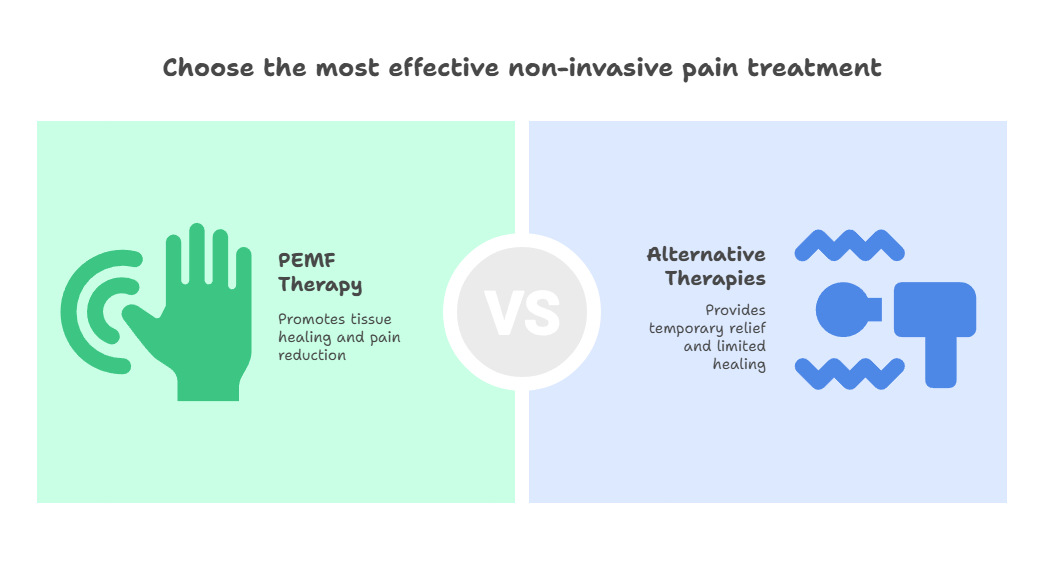
How does PEMF compare to other non-invasive treatments?
Industry analysis shows PEMF therapy superior to many alternatives. Compared to interferential current therapy, PEMF demonstrates better pain reduction and functional outcomes. Unlike TENS units that provide temporary relief, PEMF promotes actual tissue healing.
Dr. Tiziano Marovino (DPT, MPH) reports: "PEMF is safe, effective, and well tolerated by patients and should be given consideration as part of a primary pain management strategy for MSK pain disorders."
Can I use PEMF therapy with other treatments?
Research confirms PEMF therapy safely combines with conventional treatments. Studies show enhanced effectiveness when PEMF is added to physical therapy protocols. Dr. Ahmed Mohamed Elshiwi's research demonstrates:
"Adding pulsed electromagnetic field to conventional physical therapy protocol yields superior clinical improvement." No drug interactions have been reported.
How long do the benefits of PEMF therapy last?
Clinical data shows sustained improvements well beyond treatment periods. Studies demonstrate 77.4% success rates maintained at 6 months, with quality of life improvements persisting at 12 months. According to Dr. Gülşah Yaşa Öztürk: "PEMFT can be considered an effective and safe option that can be added to routine physical therapy modalities for relieving chronic low back pain frequently encountered in clinical practice."
What should I expect during my first PEMF session?
Based on clinical protocols, your first session will typically last 15-30 minutes with you lying prone while the device is positioned over your lower back. Most patients experience no sensation during treatment, though some report mild tingling. Pain relief may begin within 24 hours, with 22% of patients showing improvement on day one according to clinical trials.
Expert Predictions: The Future of PEMF Therapy in 2025-2026
Industry experts predict significant advances in PEMF therapy accessibility and effectiveness over the next 18 months.
Technology Improvements Expected
Device Miniaturization: Next-generation wearable PEMF devices will provide continuous treatment throughout daily activities
Precision Targeting: AI-guided frequency selection based on individual pain patterns and tissue characteristics
Smartphone Integration: Apps will monitor treatment compliance and adjust protocols based on real-time feedback
Clinical Integration Trends
Insurance Coverage Expansion: Growing clinical evidence may lead to coverage decisions by major insurers in 2026
Primary Care Adoption: Family physicians increasingly recommending PEMF as first-line treatment for chronic pain
Hospital Integration: Major medical centers adding PEMF protocols to standard pain management programs
Dr. Jonathan Lazar reports: "BEMER has helped me offer a higher level of care and better results to my patients. We've seen patients have incredible turnarounds when they combine our care with the benefits of in-home, lifestyle support from BEMER."
Research Developments
Large-Scale Trials: Multi-center studies with 500+ participants planned for 2025-2026
Protocol Standardization: International consensus guidelines for optimal frequency and intensity parameters
Long-term Studies: 5-year follow-up data on sustained pain relief and quality of life improvements
Essential Resources and Tools for PEMF Therapy Success
Clinical Assessment Tools
Pain Measurement:
- Visual Analog Scale (VAS) for daily pain tracking
- Oswestry Disability Index for functional assessment
- Patient Global Impression of Change (PGIC) for treatment response
Treatment Tracking:
- Weekly pain diaries with activity correlation
- Medication usage logs to track reduction
- Sleep quality assessments using standardized scales
Recommended Reading and Research
Peer-Reviewed Studies:
- "Effectiveness of Electromagnetic Field Therapy in Mechanical Low Back Pain" (2025)
- "Evaluating Noninvasive Pulsed Electromagnetic Field Therapy" (2024)
- "The positive effect of pulse electromagnetic field therapy on chronic low back pain" (2024)
Professional Organizations:
- International Association for PEMF Therapy
- American Academy of Pain Medicine
- International Spine Intervention Society
Device Selection Checklist
FDA Approval Verification:
□ Confirm 510(k) clearance or PMA approval
□ Verify specific indication for musculoskeletal pain
□ Check manufacturer credentials and clinical data
Technical Specifications:
□ Frequency range includes 5-50 Hz capability
□ Intensity reaches minimum 20 Gauss (2 mT)
□ Timer function for proper session duration
□ Warranty and customer support availability
Conclusion: Your Next Steps Toward Pain-Free Living
The scientific evidence is clear: PEMF therapy represents one of the most effective non-invasive treatments for back pain available in 2025. With 77% success rates, 36-78% pain reduction, and an excellent safety profile, PEMF offers hope for millions suffering from chronic back pain.
Immediate Action Items:
- Week 1: Schedule consultation with healthcare provider to discuss PEMF therapy
2.Week 2: Research local PEMF providers or FDA-approved home devices
3.Week 3: Begin treatment protocol with 15-30 minute sessions, 3-5 times weekly
4.Week 4-6: Complete initial treatment course and assess outcomes
Key Success Factors:
- Use clinically validated frequencies (5-50 Hz range)
- Maintain consistent treatment schedule (3-5 sessions weekly)
- Track progress with standardized pain scales
- Combine with conventional therapy for optimal results
According to Dr. Renato Andrade from University of Porto: "When used alone, the PEMF seem to have great effect in reducing the pain intensity in low back patients, independently of the low back pain condition."
The future of back pain treatment is here. With proper implementation of evidence-based PEMF protocols, you can join the 77% of patients who achieve significant pain relief and improved quality of life.
Sources and Citations
[1] Effectiveness of Electromagnetic Field Therapy in Mechanical Low Back Pain: A Randomized Controlled Trial (2025) - Journal of Pain Research
[2] Evaluating Noninvasive Pulsed Electromagnetic Field Therapy for Joint and Soft Tissue Pain Management (2024) - Pain Medicine Journal
[3] The positive effect of pulse electromagnetic field therapy on pain and disability in chronic low back pain: a comparative study (2024) - Springer Rheumatology International
[4] The effectiveness of pulsed electromagnetic field therapy in patients with shoulder impingement syndrome: A systematic review and meta-analysis (2024) - PLOS ONE
[5] Pulsed Electromagnetic Field (PEMF) stimulation as an adjunct to exercise: a brief review (2024) - Frontiers in Sports and Active Living
[6] Effect of pulsed electromagnetic field on nonspecific low back pain patients: a randomized controlled trial (2019) - PubMed Central
[7] Pulsed electromagnetic field therapy effectiveness in low back pain: a systematic review (2016) - PubMed Central
[8] Efficacy of pulsed electromagnetic field therapy on pain and physical function in patients with non-specific low back pain: a systematic review (2023) - Springer
[9] PEMF therapy for persistent pain following lumbar surgery: pilot study (2018) - PubMed Central
[10] ActiPatch: Can It be a Tool to Empower Chronic Pain Patients? (2020) - PubMed Central



